1996 PONTIAC BONNEVILLE engine oil
[x] Cancel search: engine oilPage 6 of 387
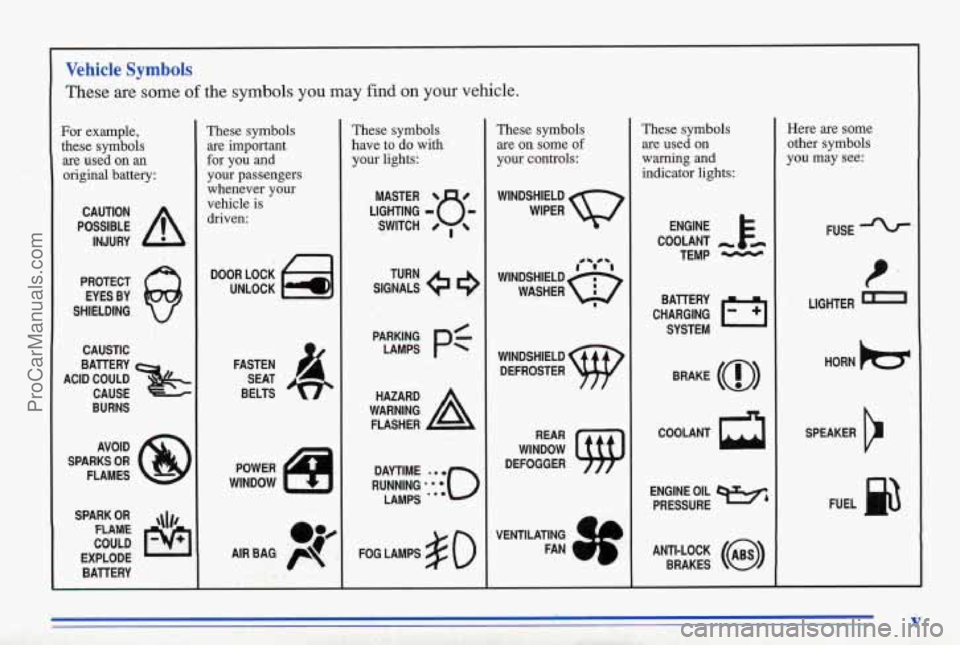
Vehicle Symbols
These are some of the symbols you may find on your vehicle.
For example, these symbols are used on
an
original battery:
POSSIBLE A
CAUTION
INJURY
PROTECT EYES BY
SHIELDING
CAUSTIC
BURNS AVOID
SPARKS
OR
FLAMES
SPARK
OR ,\I/,
COULD
RAM€
EXPLODE BATTERY
These symbols are
important
for you and
your passengers whenever your
vehicle
is
driven:
f-l DOOR LOCK
UNLOCK
FASTEN SEAT
BELTS
e?
AIR BAG p
These symbols
have to do with your lights:
SIGNALS e
TURN
PARKING
p$ LAMPS
FOG LAMPS
$0
These symbols are on some of
your controls:
WIPER Q
WINDSHIELD
DEFROSTER
VENTILATING
FAN - )
These symbols are used on
warning
and
indicator lights:
ENGINE
COOLANT
- e-
TEMP -
CHARGING I-1
BATTERY
SYSTEM
BRAKE
(0)
COOLANT a
ENGINE OIL e,
PRESSURE
ANTI~LOCK (@)
BRAKES
Here are some
other symbols
you
may see:
FUSE
LIGHTER
m
HORN )tr
SPEAKER
b
FUEL p3
v
ProCarManuals.com
Page 71 of 387
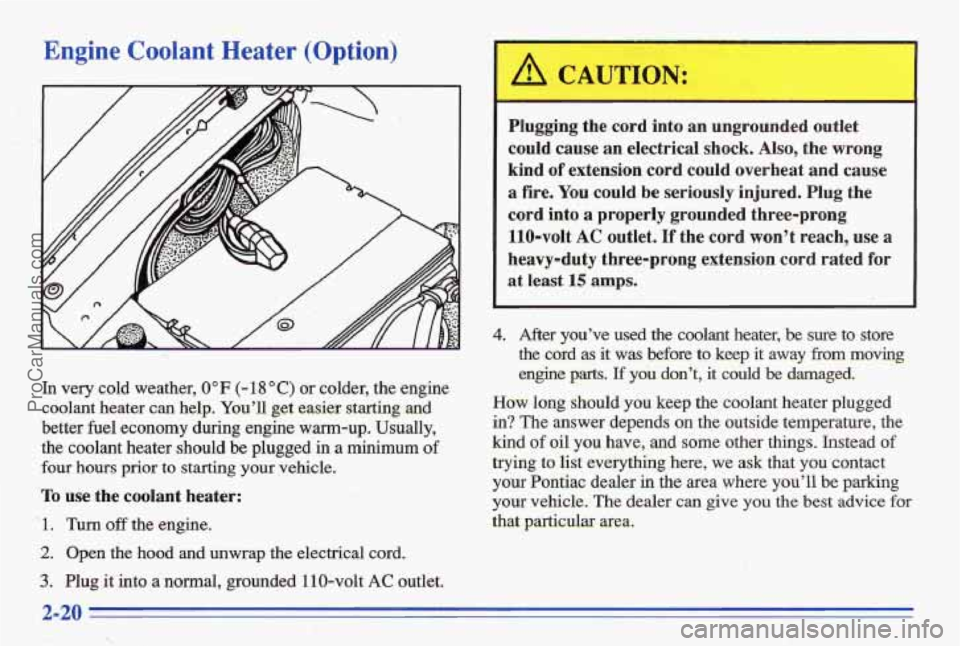
Engine CoolantKeater (Option)
In very cold weather, 0" F (- 18 O C) or colder, the engine
coolant heater
can help. You'll get easier starting and
better fuel economy during engine warm-up. Usually,
the coolant heater should
be plugged in a minimum of
four hours prior to starting you vehicle.
To use the coolant heater:
'' 1. Turn off the engine.
2. Open the hood and unwrap the electrical cord.
3. Plug it into a normal, grounded 1 10-volt AC outlet.
A. CAUTION:
Plugging the cord into an ungrounded outlet
could cause an electrical shock.
Also, the wrong
kind
of extension cord could overheat and cause
a fire. You could be seriously injured. Plug the
cord into
a properly grounded three-prong
110-volt
AC outlet. If the cord won't reach, use a
heavy-duty three-prong extension cord rated for
at least 15 amps.
,
4. After you've used the coolant heater? be sure to store
the cord as it was before to keep it away fiom moving
engine parts.
If you don't, it could be damaged.
How long should YQU keep the coolant heater plugged
in? The answer depends on the outside temperature, the
kind of oil you have, and some other things. Instead of
trying to list everything here, we ask that you contact
your Pontkc dealer
in the area where you'll be parking
your vehicle. The dealer can give you the best advice for
that particular mea.
ProCarManuals.com
Page 122 of 387
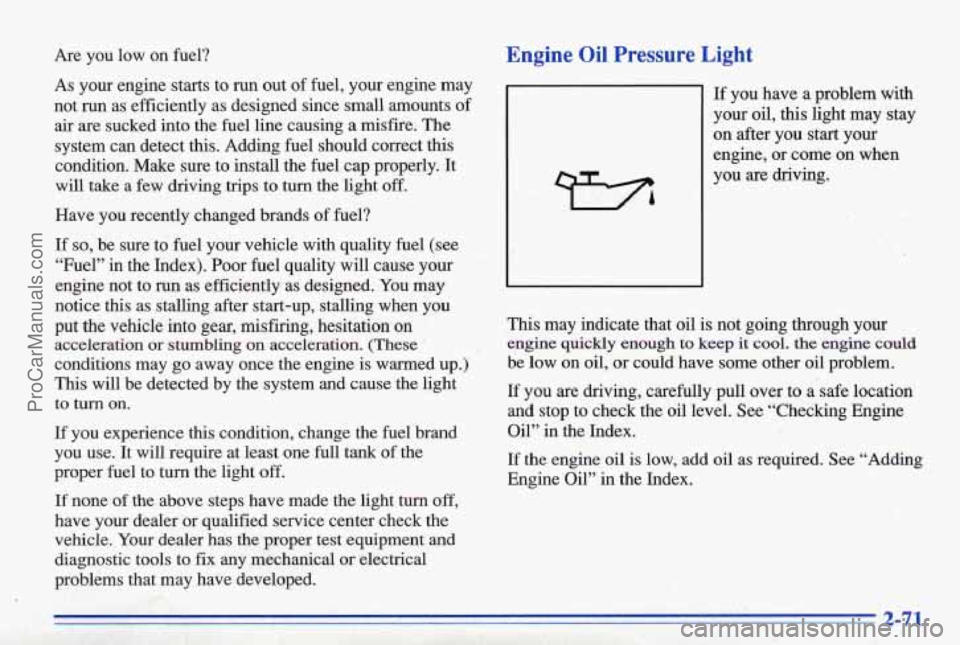
Are you low on fuel?
As your engme starts to run out of fuel, your engine may
not run as’ efficiently as designed since small- amounts
of
air are sucked into the fuel line causing a misfire. The
system can detect this. Adding fuel should correct this
condition. Make sure to install the fuel cap properly. It
will take a few driving ,trips
to turn the light off.
Have you recently changed brands of fuel?
If so, be sure to fuel your vehicle with quality fuel (see
“Fuel”
in the Index). Poor fuel quality will cause your
engine not to run as efficiently as designed.
You may
notice
this as stalling after start-up, stalling when you
put the vehicle into gear, misfiring, hesitation on
acceleration or
stumbling on acceleration. (These ’
conditions may go away once the engine is warmed up.)
This will be detected by the system and cause the light
to
Imn on.
If you experience this condition, change the fuel brand
you use. It will require at least one full tank of the
proper fuel
to turn the light off.
If none of the above steps have made the light turn off,
have your dealer or qualified service center check the
vehicle. Your dealer has the proper test equipment.
and
diagnostic tools to fix any mechanical or electrical
problems that may have developed.
Engine Oil Pressure 1,ig.ht
If you have a problem with
your oil, this light may
stay
on after you start your
engine,
or come on when
you are driving.
This may indicate that oil is not going through your
engine quickly enough to keep it cool. the engine could
be low on oil, or could have some other oil problem.
If you are driving, carefully pull over to a safe location
and stop to check the oil level. See “Checking Engine
Oil” in the Index.
If the engine oil is low, add oil as required. See “Adding
Engine
Oil” in the Index.
3 71
ProCarManuals.com
Page 123 of 387
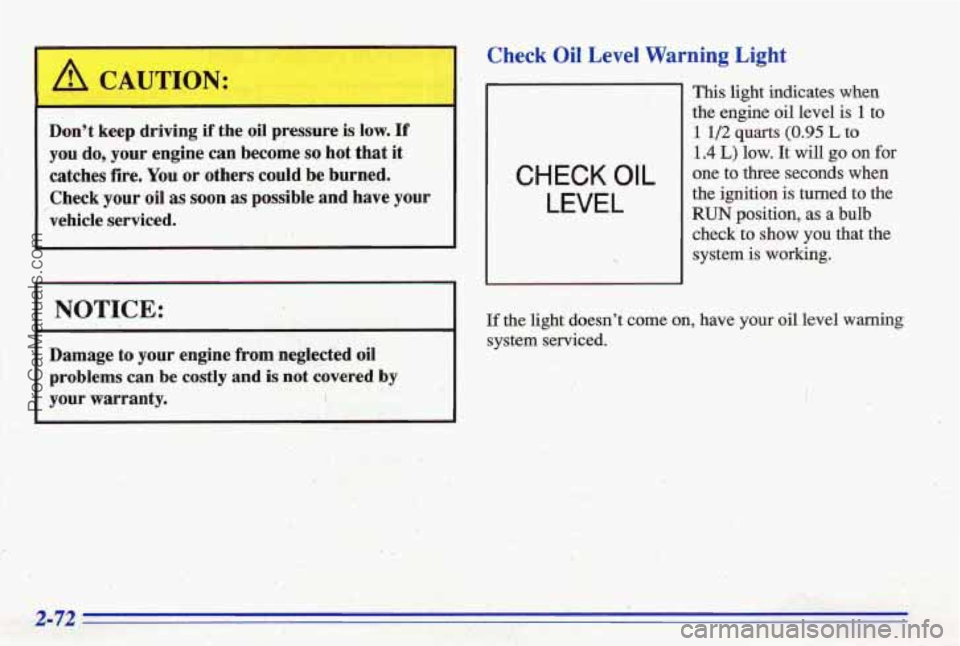
I /r CAUTION:
Don't keep driving if the oil pressure is low. If
you do,. your engine can become so hot that it
catches fire.
You or others could be burned.
Check your oil
as soon as possible and have your
vehicle serviced.
I NOTICE: Ir
r
~ ~~
Damage to your engine from neglected oil
problems can be costly and is not covered by
your warranty.
- '
Check Oil Level Warning Light
CHECK OIL
LEVEL
This light indicates when
the engine
oil level is 1 to
1 1/2 quarts (0.95 L to
1.4 L) low. It will go on for
one to three seconds when
the ignition
is turned to the
RUN position, as a bulb
check to show you that the
system
is working.
If the light doesn't come on, have your oil level warning
svstem serviced.
:? ' .C. .:
ProCarManuals.com
Page 124 of 387
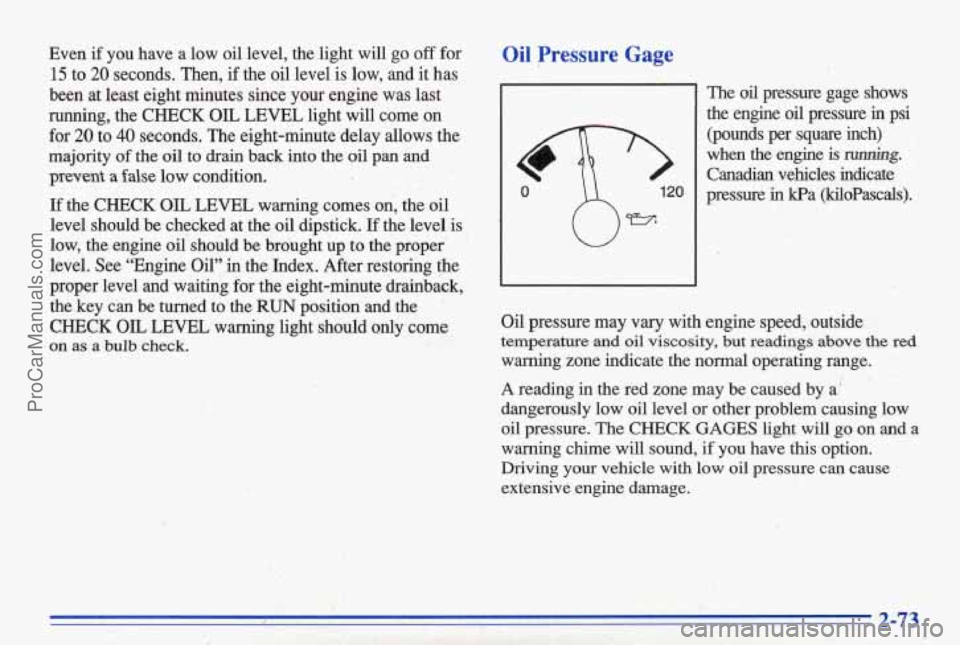
Even if you have a low oil level, the light will go off for
15 to 20 seconds. Then, if the oil level is low, and it has
been at least eight minutes
since your engine was last
running, the
CHECK OIL LEVEL light will come on
for
20 to 40 seconds. The eight-minute delay allows the
majority of the oil to drain back into the oil pan and
prevent a false low condition.
If the CHECK OIL LEVEL warning comes on, the oil
level should be checked at the oil dipstick. If the level is
low, the engine
oil should be brought up to the proper
level. See “Engine Oil” in the Index. After restoring the\
proper level and waiting for the eight-minute drainback,
the key can be turned to the
RUN position and the
CHECK OIL LEVEL warning light should only come
on as a bulb check.
Oil Pressure Gage
The oil pressure gage shows
the engine
oil pressure in psi
(pounds per square inch)
when
the engine is rwmhg.
Canadian vehicles indicate
pressure in kPa (kiloPascals).
Oil pressure may vary with engine speed, outside
temperature and oil viscosity, but readings above the red
warning zone indicate the normal operating range.
A reading in the red zone may be caused by a,’
dangerously low
oil level or other problem causing low
oil pressure.
The CHECK GAGES light will go on and. a
warning ch@e
will sound, if you have this option.
Driving your
vehicle with low oil pressure can cause
extensive ,engine, damage.
ProCarManuals.com
Page 130 of 387
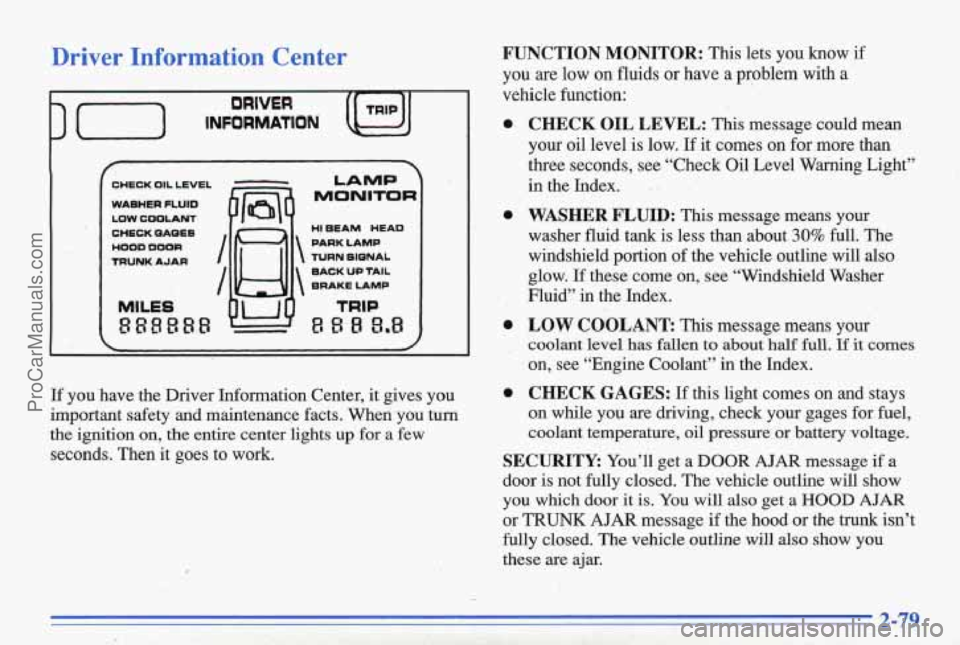
Driver Information Center
3 (-1 INFORMATION (I , J,
DRIVER TRIP
CHECK OIL LEVEL
WASHER FLUID
LOW COOLANT
CHECK QAOES
VOOD DOOR
TRUNK AJAR I
I
MlLES
888888
LAMP
MONITOR
TURN SIQNAL
BACK UP TAIL
BRAKE LAMP
TRIP
8 B 8 8.8
If you have the Driver Information Center, it gives you
important safety and maintenanc,e facts. When you turn
the ignition on, the entire center lights
up for a few
seconds. Then it goes to work.
. ..
..
.. -*
FUNCTION MONITOR: This lets you know if
you are low on fluids or have a problem with a
vehicle function:
CHECK OIL LEVEL: This message could mean
your oil level is low.
If it comes on for more than
three seconds, see "Check Oil Level
Warning Light" . ..
in the Index. - I
WASHER FLUID: This message means your
washer fluid tank is less than about
30% full. 'The
windshield portion of the vehicle outline
will also
glow.
If these come on, see "Windshield Washer
Fluid"
in the Index.
LOW COOLANT This message means your
coolant level has fallen to about half
full. If it comes
on, see "Engine Coolant" in the Index.
CHECK GAGES: If this light comes on and stays
on while you are driving, check your gages for fuel,
coolant temperature, oil pressure or battery voltage.
~. h I_ - I e:. ..
SECURITY: You'll get a DOOR AJAR message if a
door is not fully closed. The vehicle outline will show
you which door it is. You
will also get a HOOD AJAR
or TRUNK AJAR message if the hood or the trunk isn't
fully closed. The vehicle outline will
also show you
these are
ajar. ;,. . . ,--. . ,(/,,:-I.. - : , , .. , .. . . . .! _.
ProCarManuals.com
Page 189 of 387
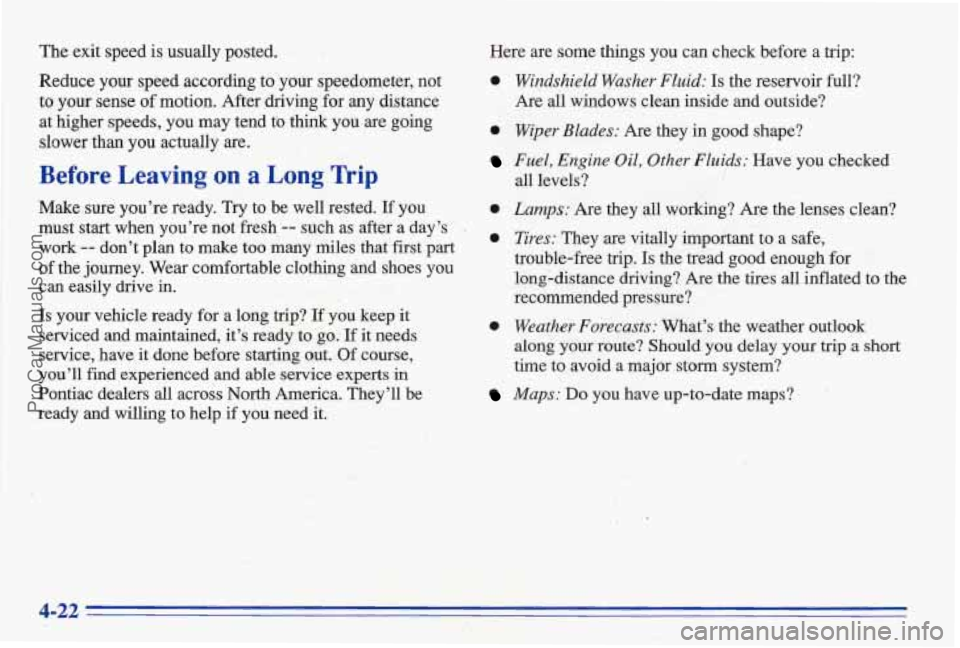
The exit speed is usually posted.
Reduce your speed according to
your speedometer, not
to your sense of motion. After driving for any distance
at higher speeds, you may tend
to think you are going
slower than
you actually are.
Before Leaving on a Long Trip
Make sure you’re ready. Try to be well rested. If you
. must start when you’re not fresh -- such as after a day’s
work
-- don’t plan to make too many miles that first part
of the journey. We,ar comfortable clothing and
shoes you
can easily drive in.
Is your vehicle ready for a long trip? If you keep it
serviced and maintained, it’s ready to
go. If it needs
service, have it done before starting out.
Of course,
you’ll find experienced and able service experts in
Pontiac dealers all across North America. They’ll be
ready and willing to help,if you need
it.
Here are some things you can check before a trip:
0 Windshield Washer Fluid: Is the reservoir full?
Are all windows clean inside and outside?
0 Wiper Blades: Are they in good shape?
Fuel, Engine Oil, Other Fluids: Have you checked
all levels?
0 Lamps: Are they all working? Are the lenses dean?
0 Tires: They are vitally irnportmt to a safe,
trouble-free trip.
Is the tread good enough for
long-distance driving? Are the tires
all inflated to the
recommended pressure?
0 Weather Forecasts: What’s the weather outlook
along your route? Should you delay your trip a short
time to avoid a major storm system?
Maps: Do you have up-to-date maps?
ProCarManuals.com
Page 205 of 387
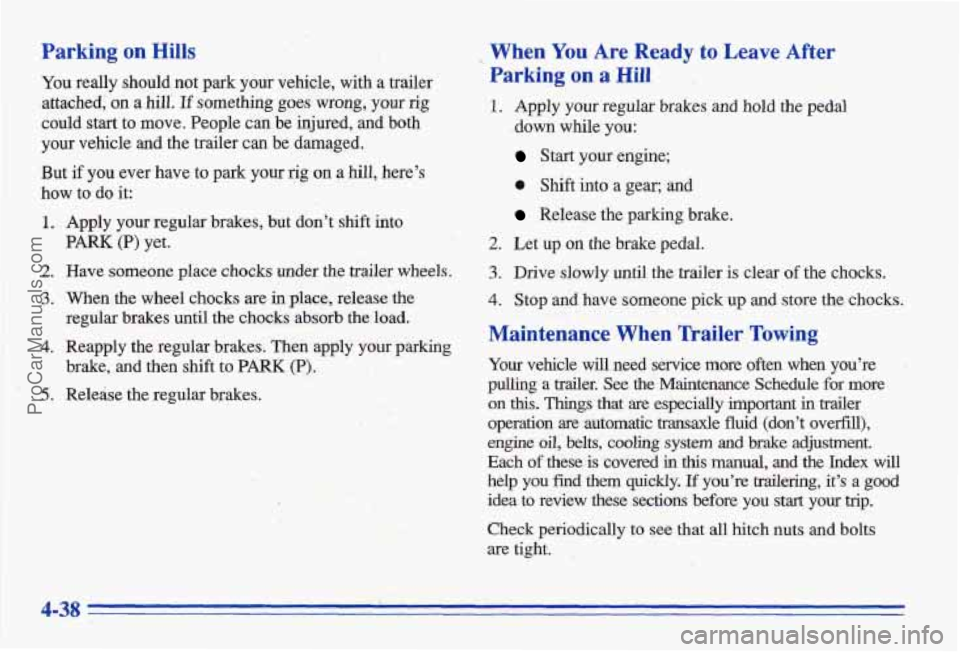
Parking on Hills
You really should not park your vehicle, with a trailer
attached,
on a hill. If something goes wrong, your rig
could start to move. People can be injured, and both
your vehicle and the trailer can be damaged.
But
if you ever have to park your rig on a hill, here’s
how to do it:
1. Apply your regular brakes, but don’t shift into
2. Have someone place chocks under the trailer wheels.
3. When the wheel chocks are in place, release the
regular brakes
mil the chocks absorb the load.
4. Reapply the regular brakes. Then apply your pa;rking
brake, and then shift to PdRK (P).
PARK (P) yet.
’ 5. Release the regular brakes.
~ When You Are Ready to Leave After
Parking on a Hill
1. Apply your regular brakes and hold the pedal
.down while
you:
Start your engine;
e Shift into a gear; and
Release the parking brake.
2. Let up on the brake pedal.
3. Drive slowly until the trailer is clear of the chocks.
4. Stop and have someone pick up and store the chocks.
Maintenance When Trailer Towing
Your vehicle will & service more often when you’re
pmg a trde~ See the Mainte~nance Schedule for more
on this. Things that are especially important in trailer
operation are .automatic
trande fluid (don’t overfill),
engine
oil, belts, cooling system and brake adjustment.
Each
of these is-covered in this manual, and the Index will
help you kd them quickly. If you’re tradering, it’s a good
idea to review these sections before you start your trip.
Check periodically to see that all hitch nuts and bolts
are tight.
4-38
ProCarManuals.com